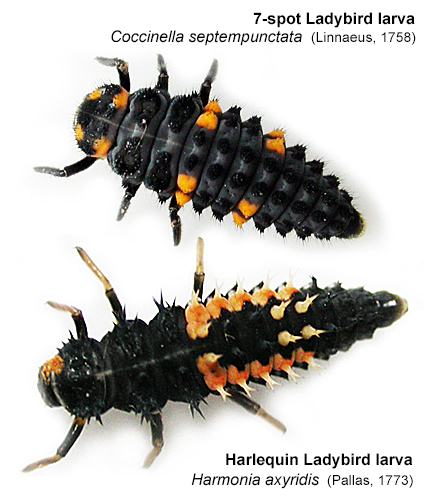

| A photographic guide to the ladybird larvae of Nottinghamshire |
| There has to be no doubt, that ladybirds are among our most easily recognised beetles and even those people with little interest in natural history or insects at all, are still able to identify them from a very young age. Because they are so easily recognised by their bright colours and elytral spots, they often conjure up childhood memories of hot Summer days in the garden, park or countryside and so are genuinely loved by both children and adults alike. |
| ...... |
| But their
larvae are often seen as frequently as the adult beetles themselves,
especially so in the case of both 7-spot and Harlequin Ladybirds, which
are two of our commonest species and probably the most well known.
Harlequin larvae are usually very easy to find in the late Summer and
early Autumn, as they become even more obvious on walls and fences when
Aphids (the preferred food source of many of our ladybirds) become short
in supply. At this time, if their growth is still incomplete, they will often turn cannibalistic and eat other ladybird larvae (including their own) and while the Harlequin gets all the bad press for this cannibalistic habit, 7-spot Ladybird larvae will do exactly the same thing in rare instances when Aphid numbers drop through drought or naturally towards the end of Summer. But not all ladybird larvae are so easily found though and despite many years looking, there are still some larvae of those species typically representative of people's concept of a ladybird, which have always eluded us. About this guide This is a simple, general photographic guide dealing only with the larvae of Nottinghamshire's commoner ladybirds, which obviously are those people are more likely to come across. Remember that all ladybird larvae go through a number of growth stages (called instars) before pupating and eventually emerging as an adult. Their appearance can change through the various instars, but there are usually some key light markings which are present through all stages. |
 |
| ...... |
| The larvae of some species can
be extremely similar (check 14-spot Ladybird and Cream-spot Ladybird) so
compare specimens carefully. Full grown larvae of all species can be
identified with a degree of care from good quality photographs. The length of larval life varies between species and is generally dependent on both food supply and weather conditions at the time. It is rare to get more than one species on the same plant at the same time and some of the species featured, will have to be deliberately looked for. |
| Pine
Ladybird Exochomus quadripustulatus (Linnaeus, 1758) |
||||||||||||||||||||||||||||||||
|
||||||||||||||||||||||||||||||||
| 16-spot
Ladybird Tytthaspis sedecimpunctata (Linnaeus, 1758) |
||||||||||||||||||||||||||||||||
|
||||||||||||||||||||||||||||||||
| Striped Ladybird Myzia
oblongoguttata (Linnaeus, 1758) |
||||||||||||||||||||||||||||||||
|
||||||||||||||||||||||||||||||||
| 14-spot
Ladybird Propylea
quattuordecimpunctata (Linnaeus, 1758) |
||||||||||||||||||||||||||||||||
|
||||||||||||||||||||||||||||||||
| Cream-spot
ladybird Calvia
quattuordecimguttata (Linnaeus,
1758) |
||||||||||||||||||||||||||||||||
|
||||||||||||||||||||||||||||||||
| Orange
Ladybird Halyzia
sedecimguttata
(Linnaeus, 1758) |
||||||||||||||||||||||||||||||||
|
||||||||||||||||||||||||||||||||
| 22-spot
Ladybird
Psyllobora
vigintiduopunctata (Linnaeus,
1758) |
||||||||||||||||||||||||||||||||
|
||||||||||||||||||||||||||||||||
| Eyed
Ladybird Anatis
ocellata (Linnaeus, 1758) |
||||||||||||||||||||||||||||||||
|
||||||||||||||||||||||||||||||||
| Larch
Ladybird Aphidecta
obliterata (Linnaeus, 1758) |
||||||||||||||||||||||||||||||||
|
||||||||||||||||||||||||||||||||
| Adonis
Ladybird Hippodamia variegata
(Goeze, 1777) |
||||||||||||||||||||||||||||||||
|
||||||||||||||||||||||||||||||||
| 7-spot
Ladybird Coccinella
septempunctata (Linnaeus, 1758) |
||
| 11-spot
Ladybird
Coccinella
undecimpunctata (Linnaeus, 1758) |
||||||||||||||||||||||||||||||||
|
||||||||||||||||||||||||||||||||
| 2-spot
Ladybird Adalia bipunctata (Linnaeus, 1758) |
|||||||||||||||||||||||||||||
|
|
|
||||||||||||||||||||||||||||
| 10-spot
Ladybird Adalia
decempunctata (Linnaeus, 1758) |
||||||||||||||||||||||||||||||||
|
||||||||||||||||||||||||||||||||
| Harlequin
Ladybird Harmonia axyridis (Pallas, 1773) |
||||||||||||||||||||||||||||||||
|
||||||||||||||||||||||||||||||||
| Cream-streaked
Ladybird Harmonia quadripunctata (Pontoppidan, 1763) |
||
| 24-spot
Ladybird Subcoccinella
vigintiquattuorpunctata (Linnaeus, 1758) |
||||||||||||||||||||||||||||||||
|
|
|
|||||||||||||||||||||||||||||||
| Beetles |
| Homepage |